You may have heard of mead before or maybe you haven’t, but one image that always seems to come to mind when mead is mentioned is Vikings drinking their grog. I don’t know a whole lot about Vikings, but I do know a bit about mead! Mead is a fermented honey and water mixture, some call it honey wine, and it is quite possibly the first fermented drink that humans purposefully made. Luckily for us, it’s quite easy to make your own mead! I’m going to show you how to make one gallon of mead with this simple blueberry orange mead recipe.
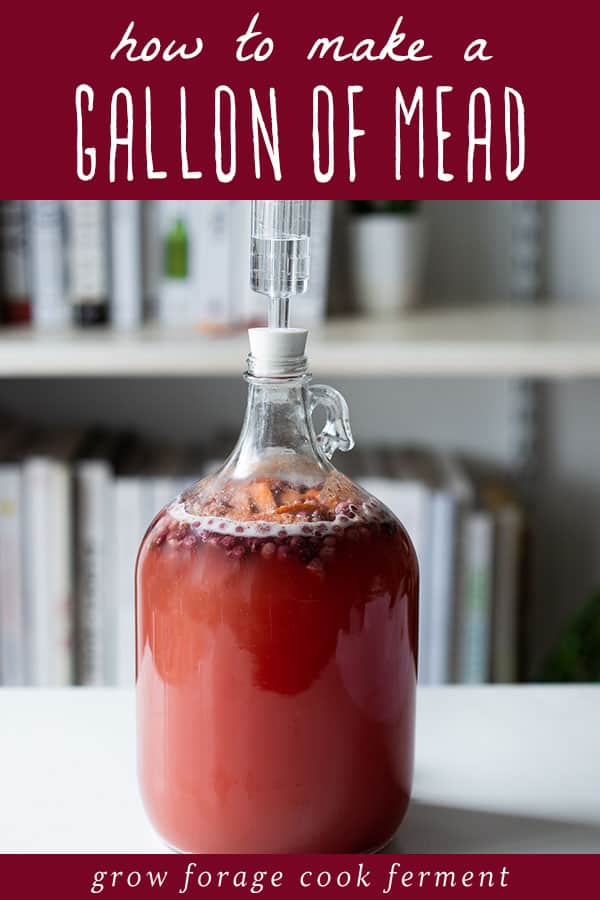
Want to save this post for later?
Simple Mead Making eBook
Want to learn more about making mead? I have a Simple Mead Making for Beginners eBook just for you!
It has ingredient and equipment checklists, detailed instructions for brewing and bottling your mead, and simple mead recipe ideas! Be sure to check it out if you’re new to the mead making process and want a step by step guide.
One Gallon Mead Recipe
Here is my simple method for making one gallon of mead!
What is Mead?
Mead is a fermented alcoholic beverage that is traditionally made with just honey and water, and maybe some yeast (wild yeast is often used).
Whenever you add fruit to mead it’s technically called a melomel rather than mead. I still usually default to calling it mead, though.
You could also use apple cider instead of water and then you’d have what’s called a cyser. If you add herbs and spices or other flavorings it’s called a metheglin.

Mead Equipment and Ingredients
There is some special equipment and ingredients that you will need to make this mead.
Rather than list it all here, I’ve created a page that has links to all of my favorite mead ingredients and equipment: Mead Equipment & Ingredients: Everything You Need to Get Started.
There you will find links to the sanitizer, brewing jugs and buckets, airlocks, yeast, tubing, bottles, and honey and I recommend!

How to Make Mead: One Gallon Mead Recipe
Alright, let’s get started on making this mead!
This is a recipe for one gallon of mead, but I’m always of the mind that if you’re making one you might as well make two.
You can split a package of brewing yeast up between two jugs (one package can make up to 5 gallons of mead).
Sanitize Everything
The first thing to do is sanitize everything that will be used in the brewing process: the jug, airlock, big pot, spoon and funnel.
Simply follow the directions on the sanitizer and don’t throw it out until you’re totally done (just in case your dog licks the funnel or you drop your spoon).
Make the Mead Must
Once everything is sanitized, put about 1/2 gallon of non-chlorinated (filtered) water in a large pot on medium heat. When it’s warm, but not boiling, add the honey and stir until it dissolves.
Using two pounds of honey will make a very “dry” mead (not sweet), while three pounds will create a sweeter mead.
The type of yeast you use will also affect how dry or sweet the mead is.
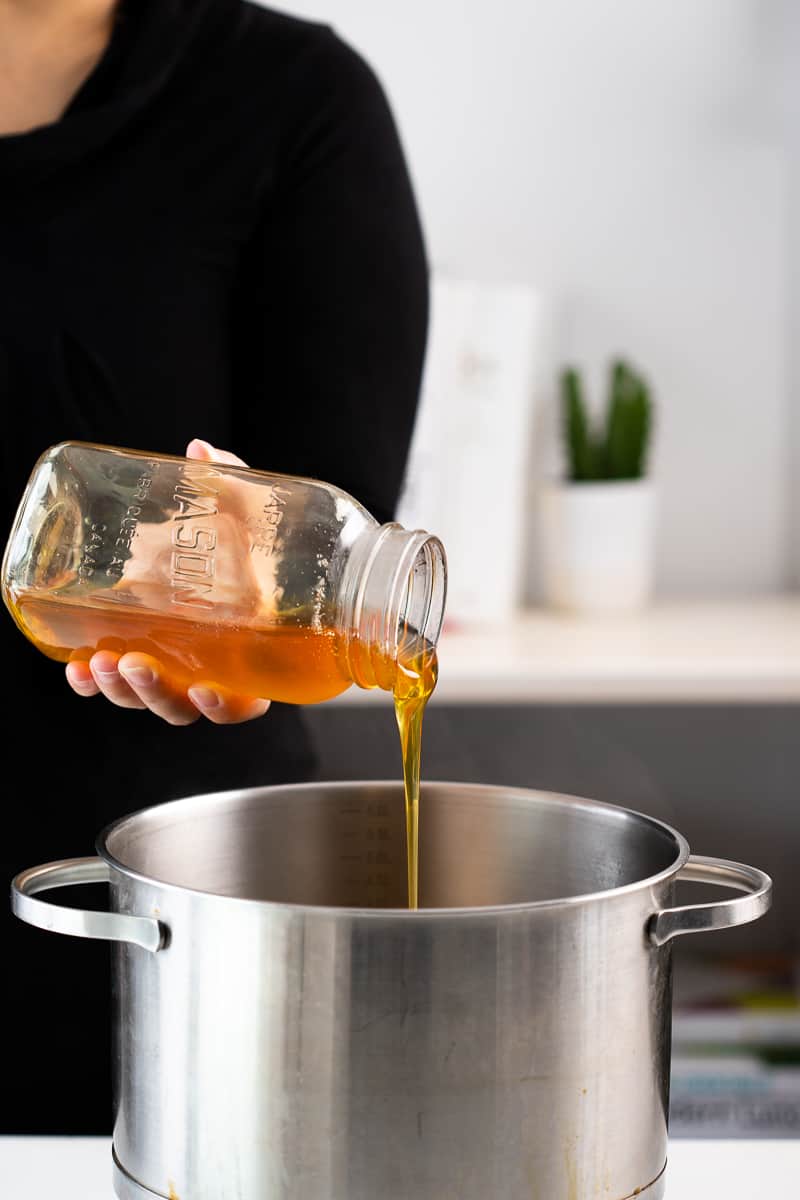
Turn the heat off. It may be a little foamy, but that’s ok.
In the meantime, put the berries (or any fruit of your liking), orange slices (skin and all), and raisins into the one gallon jug.
Raisins are added as a natural nutrient for the yeast. You will not notice any flavor from them in the finished mead.
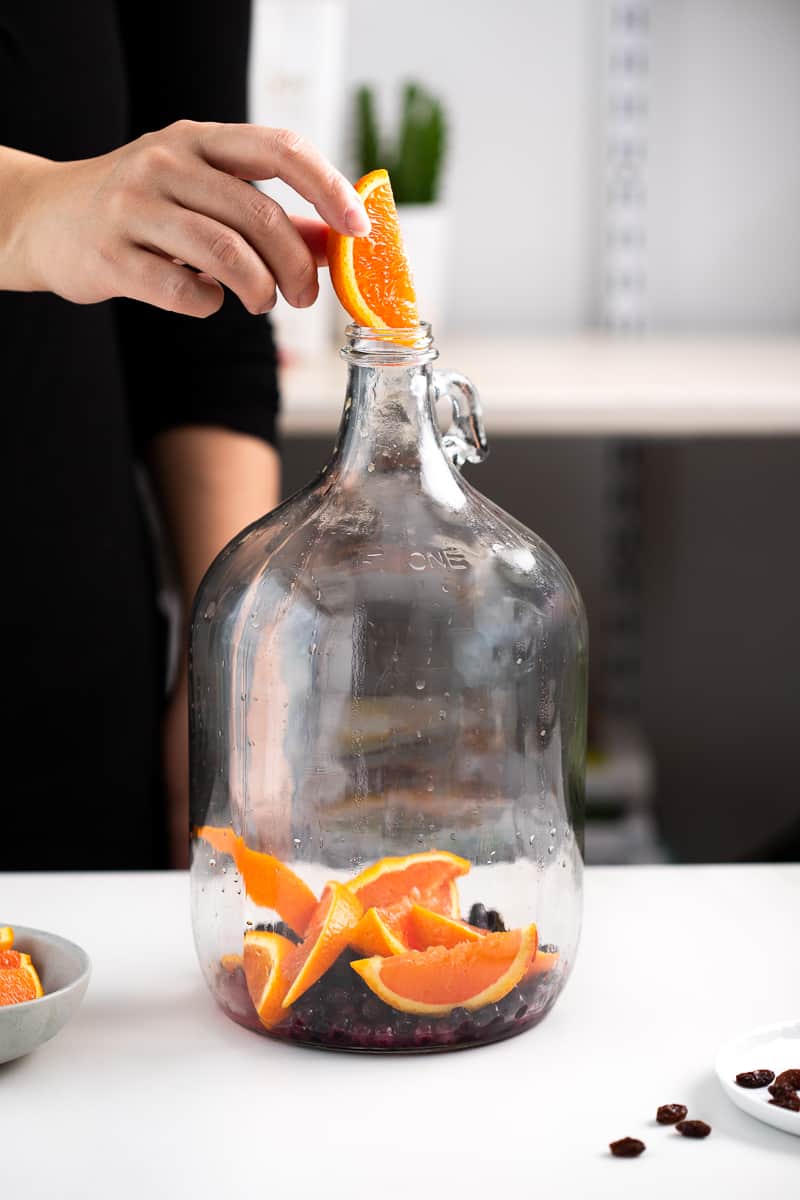
Then, using the funnel, carefully pour the honey water mixture (technically called “must”) into the jug.
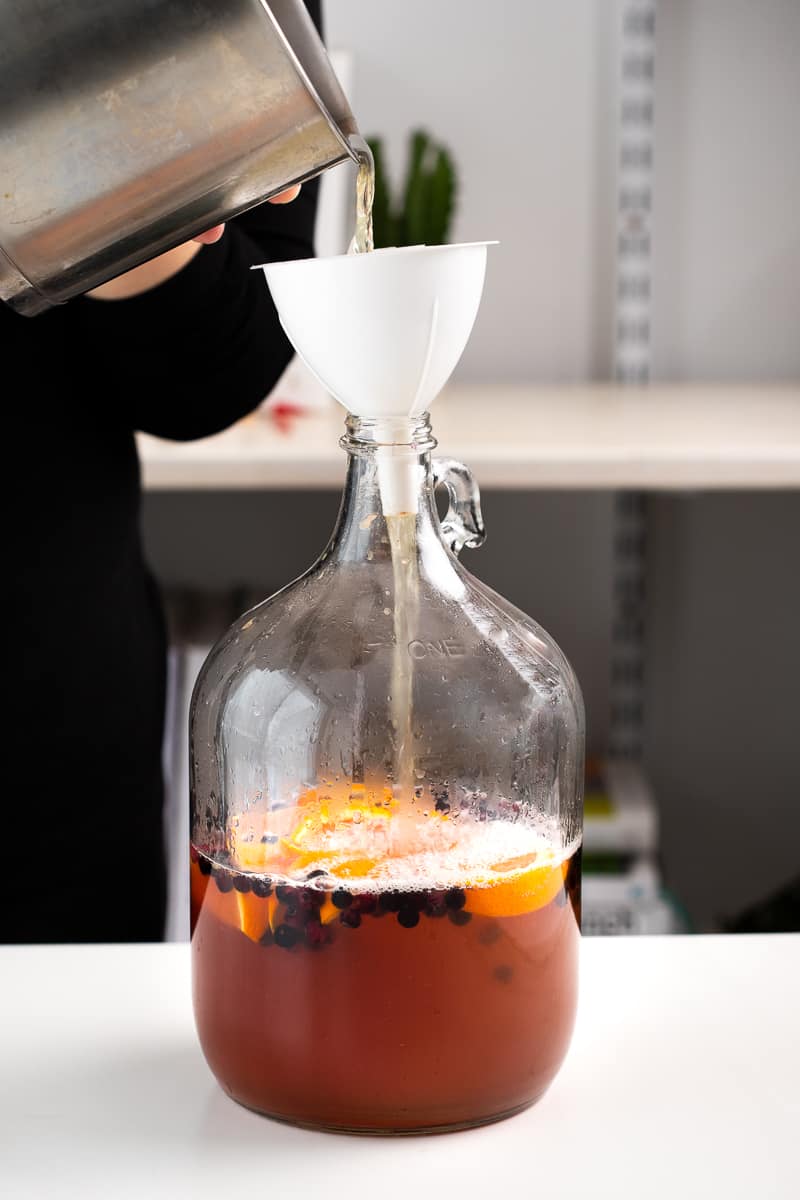
Top off the jug with cool non-chlorinated (filtered) water, leaving at least 2 inches of head space on top.
Then put the lid on the jug and gently mix everything around a bit. If you bought a jug that came with an airlock it may not come with a lid, so you’ll have to find a lid that fits or improvise a bit here. A solid cork (without a hole for the airlock) would work.
Pitch the Yeast
The next step is to add the yeast, but you need to make sure that it isn’t too hot, which will make your yeast inactive. It should feel lukewarm, no more than 90° F (32° C). I recommend using a thermometer before adding the yeast to be sure.
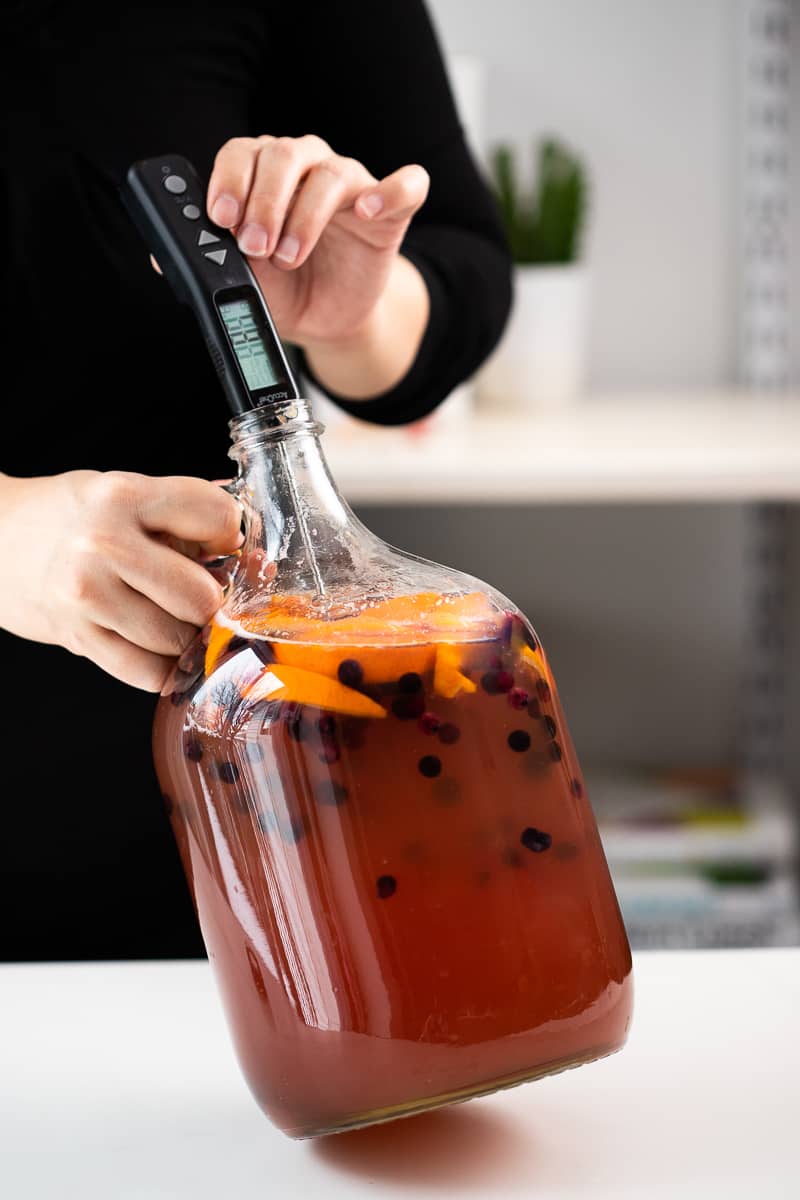
Once it is less then 90° F you can pitch the yeast into the jug.
You don’t need to use the whole package of yeast for one gallon, 1/2 package is enough (it doesn’t have to be an exact measurement). Store the opened yeast package with the remaining yeast in an airtight zip top bag in the refrigerator for later use.
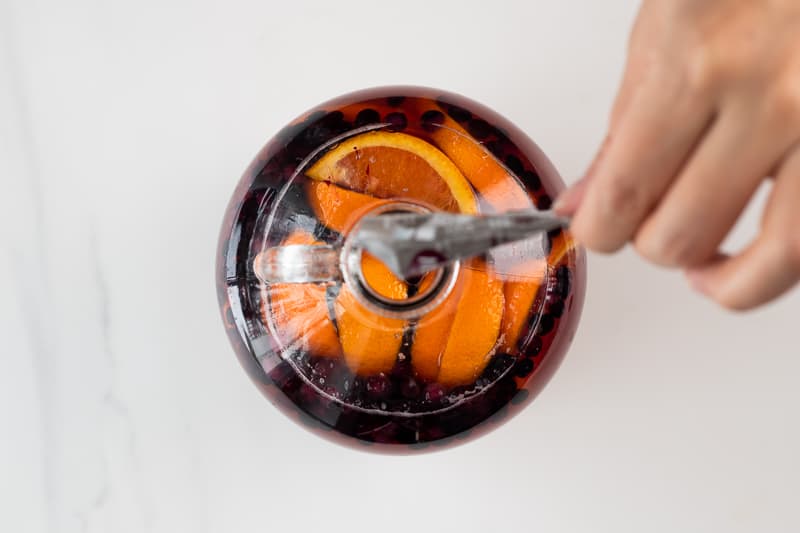
Now the fermentation fun can begin!

Once you’ve pitched the yeast, put the lid back on tightly and this time you’re really going to shake it up for several minutes.
It’s a good workout for your arm muscles, so you can skip the gym on days when you make mead!
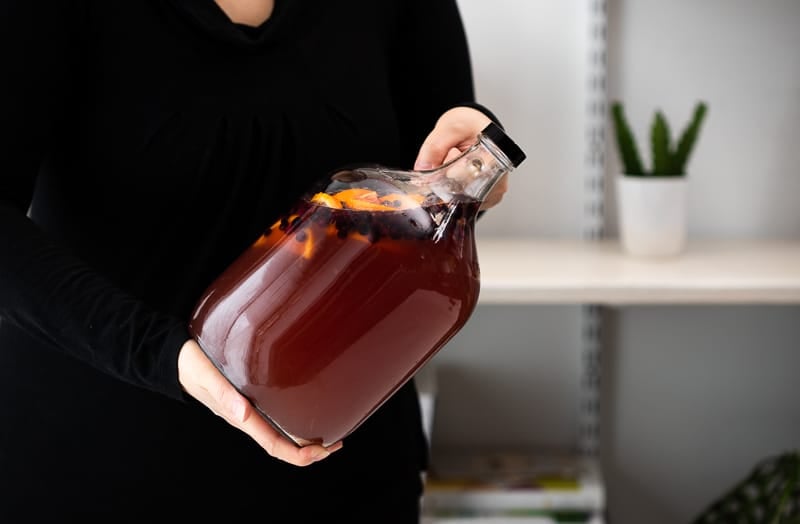
Add the Airlock
Put a little water in the airlock to the line, then put the rubber stopper into the jug.
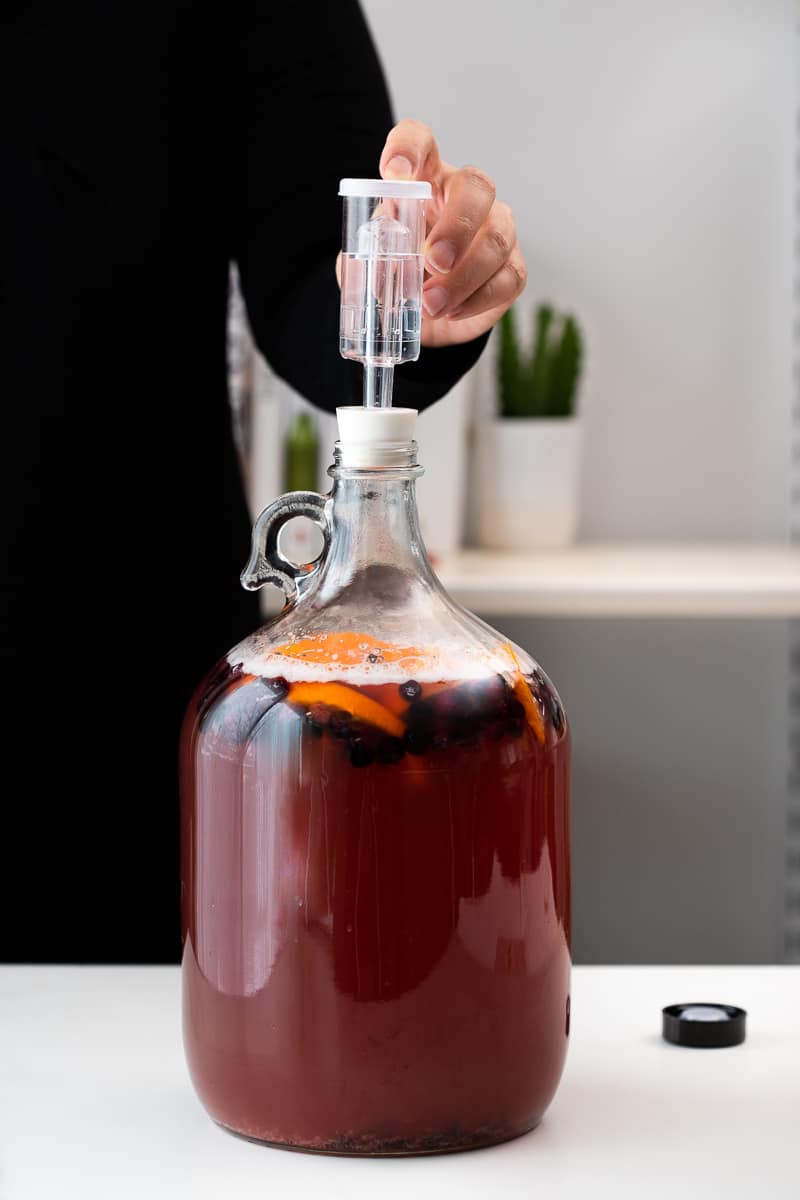
In a few hours you should start to see bubbles forming in the jug and in the airlock.
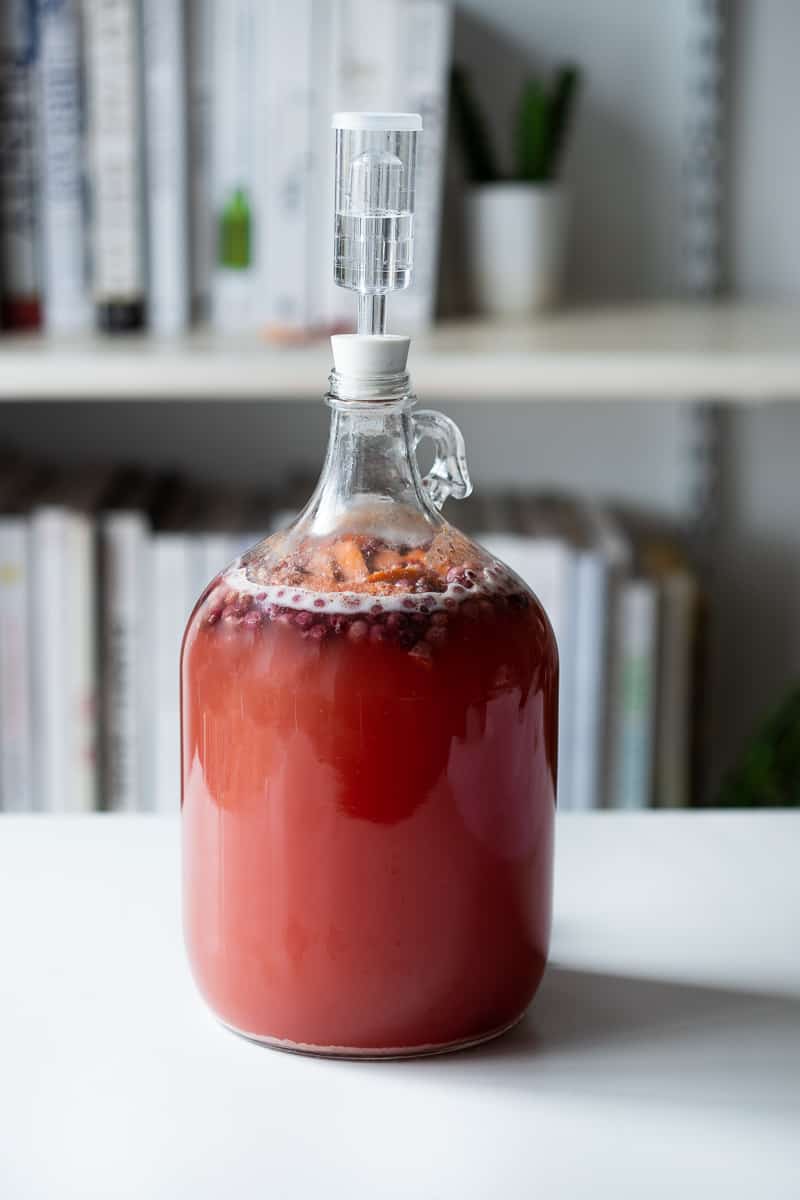
After several hours or overnight, you may see a lot of bubbles rising up the neck of the bottle! The whole top might get a little foamy at first, but things will settle down.
Don’t worry if the bubbles rise up into the airlock for the first couple of days, that just means that you have a very active (and happy) batch of mead! You can periodically remove the airlock to rinse it out, then replace it back into the jug.
I love watching all the little bubbles! Fermentation is so cool.

Set Aside to Ferment
Keep the jug in a cool (not cold) dark place out of direct sunlight to ferment.
Mead can take longer to ferment than hard cider or beer, depending on the ambient temperature it will take anywhere from 3-6 weeks.
I usually give it 5-6 weeks before bottling to be on the safe side, as you don’t want any broken bottle explosions! I’ve definitely had some very champagne like mead before.
You want to wait until you don’t see any bubbles in the jug and your airlock is still before bottling.
Bottle the Mead
Bottling one or two gallons of mead is the same process as bottling hard cider. Follow my tutorial there to get a detailed process.
You may want to wait a while to drink your mead as it definitely gets better with age.
I often drink it “green” (young) as I enjoy it either way. It is fun to save a couple of bottles for several months, or even a year, just to see how the taste changes with age.
More Mead Recipes
Now that I’ve shown you how to make this simple one gallon of mead recipe, chances are you will want to make more soon!
I have written posts on How to Make 5 Gallons of Mead and How to Bottle 5 Gallons of Mead if you want to try making a larger batch.
I have one gallon mead recipes for Wildflower Mead, Dandelion Mead, Blackberry Mead, Elderberry Mead, Elderflower Sparkling Mead, and Maple Orange Mead that are all delicious and follow this same basic mead recipe.
See my post on 15 Easy Mead Recipes for Beginners for even more!
If hard cider is your thing, see my posts on brewing hard cider and making hard cider with wild yeast.
Be sure to check out my Simple Mead Making: A Beginner’s Guide to One Gallon Batches eBook for more detailed information on brewing, bottling, and recipe ideas!
Cheers and happy mead making!
Simple One Gallon Mead Recipe
Equipment
Ingredients
- water non-chlorinated or filtered
- 2-3 pounds honey depending on how sweet you want to end product to be.
- berries or fruit of any kind fresh or frozen, about a cup
- 1 orange
- 10 raisins
- 1/2 package champagne yeast or other wine yeast
Instructions
- Sanitize everything that will be used in the brewing process.
- Heat about 1/2 gallon of non chlorinated water in the pot on medium heat. Once it's warm, but not boiling, add the honey and stir it so it all dissolves. Turn off the heat.
- Put the berries or other fruit, orange slices (skin and all), and raisins into the one gallon jug.
- Use the funnel and carefully pour the honey water mixture into the jug.
- Top off the jug with cold (preferably filtered) water, leaving at least 2 inches of head space on top. Put the lid on the jug and gently mix everything around a bit.
- Make sure that the temperature of the must is below 90°F, then add 1/2 packet of champagne yeast. Put the lid back on tightly and this time shake the jug for a minute or two to distribute the yeast.
- Put a little water in the airlock to the line, then put the rubber stopper end into the jug. Put the jug in a dark place. It should start bubbling within 12-24 hours.
- After about 4-6 weeks of fermenting, once all bubbles have stopped rising in the jug and airlock, the mead can be bottled and aged.
Notes
- Please see my Mead Equipment and Ingredients page for a detailed list of what you need to get started.
- Use my tutorial on Bottling Hard Cider to bottle the mead - the process is the same. The flavor of homemade mead will improve after bottling and aging.
- My Simple Mead Making eBook is a helpful resource if you are just getting started with making your own mead.

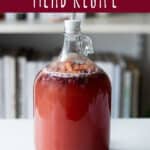
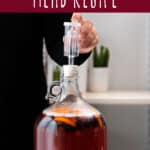

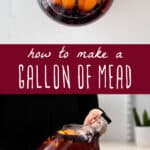
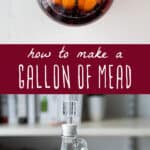
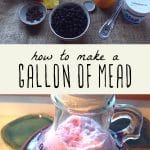
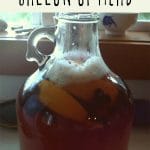
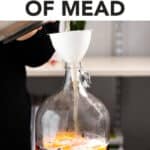
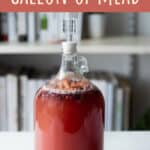
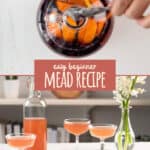




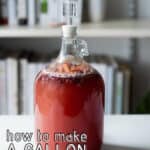
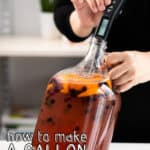
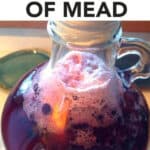
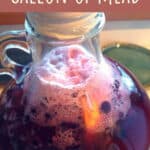
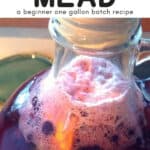
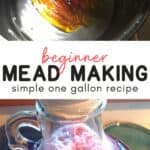
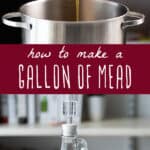
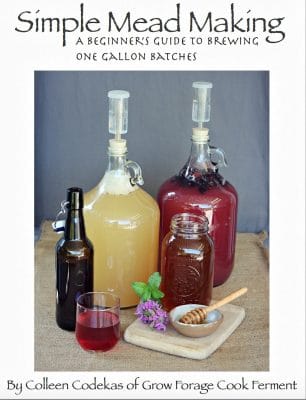


Hi Colleen.
I’ve just started looking into brewing mead so finding your recipes has come as a great relief. You make it look so simple & I feel like even I as a novice can make it work!
I digress. I’d just like to thank you for these wonderfully comprehensive recipes. 😘
I will keep you posted on all my future endeavours. 😉
Thank you so much. Enjoy!
Hey, I really wanna try this. How long do you recommend aging it? I want it decently sweet and something to really impress my Meade loving friends and myself. Also i you age it in the jug or do you bottle it and than age it? And also how specifically do you age it? Thanks can’t wait to try it.
Hi Eric. I go over how to bottle mead in this post here: How to Bottle Mead The general rule is to age your mead for at least 6 months to a year, but it’s really up to you.
So I made two batches of this on the first go-around as a newish brewer: one with 2 lbs honey, one with 3 to try a sweeter and a drier mead. I also ended up using wine additives (yeast nutrient instead of raisins, acid blend in addition to the orange) since I already had them from my first wines and it seemed to me that they could be beneficial. The “sweet” mead is very orange-flavored and the “dry” mead doesn’t have much flavor at all and is quite thin. I would guess that the excessive citrus flavor is because I doubled up the acid essentially by adding both oranges and acid blend, but do you have suggestions on why the other tastes almost watery? the only added water after making the must is from when I stabilized to back sweeten but it still is kinda thin.
Hi Paul, hmm I’m not sure why that would happen. I’ve made mead with 2 lbs honey often and it turns out very nice (but quite dry). It’s hard for me to say without seeing your process from start to finish. It may also improve after bottling!
What would the approximate A.B.V. be with this recipe? Thanks!
Hi Brian, I haven’t tested it, but you can with a hydrometer.
8-20% depending on fermentable sugar content, generally a touch stronger than wine
I’m a first time brewer and I haven’t yet made it but I’m super excited to try! I’ve been looking for an easy recipe just like this to start out on. It looks really good! I’ll update when I actually make it!
Yay, Keira! Keep me posted!
Got this mead started last night and it’s bubbling away nicely this morning. Am I correct in thinking I do not need to rack this mead? Will it be a clear by the end of the 6 weeks? Thank you for the recipe! X
Hi Hannah, you do not need to rack this mead recipe! It should be fairly clear after 6 weeks and will clear up even more after bottling.
Hey quick question, I’ve made this recipe before and never rinsed our washed my fresh fruits. A buddy of mine who brews beer advised that I wash or even boil my fresh fruits so as to introduce outside bacteria. All my batches came out pretty good, but one can never be too careful. What would you recommend? Thanks!
I personally don’t boil my fruit beforehand, but a quick rinse should be sufficient to remove any debris before fermenting.
Just curious I am looking to get into brewing so this would be my first time. I am not a big fan of honey and was looking into the possibility of using Maple syrup or maple sugar to make a mead from and I was also considering adding in apple cider in the fall when it is fresh as I have several apple orchards nearby and can get some really good fresh local cider in the fall if I used a similar amount of maple syrup would I get a similar product?
Yes, a maple mead is called an acergyln. I recipe for one here that uses primarily maple syrup, but you could omit the honey and use all maple if you wish: https://www.growforagecookferment.com/maple-mead/
I was reading up on melomels and every comment section I have seen mentions that every day you should push down any fruit that is not fully submerged to prevent mold growth.
From your experience, is this the case? Should I have been doing this? (I’m about 3 weeks into fermentation)
I didn’t see anywhere where you mentioned you needed to do this, but maybe I missed it?
Lastly, if mold starts to grow on the fruit, should I throw out the melomel and start over?
Thanks and love the site!
Hi Andy, I don’t think this is necessary. I’ve made many melomels and have never had mold form on the fruit. In fact, the alcohol that is produced during fermentation inhibits and mold growth!
When I bottle my mead, should I put it in the fridge right away or is it ok if I leave it out for a couple to few days? I just don’t have enough room in the fridge at the moment.
Hi Daria, you can leave it out of the refrigerator until you are ready to chill and drink it!
Couple questions for you, love the recipe I’ve made 2 gallons, but do I have to stir the mead at all during the process or do I have to add any yeast nutrients during the process.
Hi Kevin, for this recipe you do not need to stir or add any nutrients!
So I’ve made this recipe and this is my first time trying my hand in alcohol, it has been about 3 months now I just cleared out the sediment and I have a clear liquid but for some reason there’s still a very strong yeasty flavor is there anything I can do to fix it?
Hi Dana, this is normal and the flavor will improve after it ages for a bit!
I just finished my first batch of mead. I followed the directions, but I used 1 whole packet of premier cuvée yeast (because Amazon sent me the wrong one). Everything worked out well, it started to bubble in a few hours and everything was working out, but now after 3 weeks the airlock isn’t bubbling anymore. Does that mean it is done? I tried it and it tastes like there is alcohol, but when I put the hydrometer in it says 0%. I remember checking the liquid in the beginning and my hydrometer floated to the bottom. Is this batch a dud or should I wait a little longer? Will it become stronger after I bottle it? And should I refrigerate it for it to age or is it ok if it is room temperature?
Hi there. When the bubbling stops, it doesn’t mean that it’s no longer fermenting. I would give it longer until your hydrometer gets a proper reading.
Ok thank you! I have another batch of mead that I am making, but it’s an orange mango one and I used champagne yeast for that one. I will wait to bottle both until the orange mango one has stopped bubbling.
This recipe is currently bubbling. :) I can’t wait to try it. I’ve only made beer and wine in the past with mediocre results, and it’s been a while. I do remember a carboy transfer around mid-fermentation to syphon the top liquid away from sediment. I didn’t see that step mentioned. Is it not necessary with mead?
Hi Jan, that is called “racking” and you can definitely do it if you prefer, but it’s not required in this recipe!
I have been making ciders and mead for over 8 years now. I was wondering if anyone has tried aging their mead in an oak barrel. Just finished off the last of my previous batch. I let it age a full year after racking it twice during fermentation ( clears it up and prevents any flavor coming from the lees-layer of goop at the bottom) . For the ABV you can use a Hydrometer when you are adding the honey to measure potential alcohol content. I like mine around 10 – 12%. Anything 15% and up is a lot more hands on as anything over that requires a much sturdier yeast. You are getting into White Wine yeasts and Champagnes. Or it would require distilling. Basically, the yeast has a harder time surviving as the ABV rises. My next one will be with wild apples (Leatherbacks) and much lower ABV 6-8%. More of a cider I guess.
My first mead/melomel just got put up for fermentation. Used PNW Fireweed Honey and Raspberries. Used sweet mead/wine yeast. 3 lbs of Fireweed Honey. If this works, a 5 gallon batch is coming for Christmas Presents.
Excellent! Mead makes a wonderful holiday gift!
Fireweed honey is so amazing.
You don’t need to buy a fermentation lock. Just put a plastic bag over the neck of the bottle, held in place with a rubber band (not too tight). Fermentation will inflate the bag, and the excess pressure will push the CO2 under the rubber band without letting in air. Every day, squeeze the bag to force out the gas. It will reinflate. When it doesn’t, you are done. At this point I put the whole thing in a fridge, which kills the yeast. Let it sit a few days for the yeast to settle. Carefully pour or siphon out the wine and leave the sediment. It is now clear enough to drink. Wine yeast will allow a higher alcohol content because it gets killed by the alcohol at a higher proof. More sugar (up to a point) makes more alcohol.
This works?
Or a balloon with a pin hole or 2 in it
Could you use dried pineapple that has sugar on it ? Would it have some of the pineapple taste to the finished product ?
It may, but I would probably use fresh.
Okay ,thank you. I’m making the one from the recipe above. I can’t wait to try it.
I used frozen pineapple and orange juice. It was fruity and mild. Quite good really.
Thanks for the recipe.
Which other fruit could l use instead of orange? Thanks
Any other citrus fruit would be fine. In this recipe, the acidity in the orange is used to balance the flavor. The mead itself isn’t orange flavored.
I have lots of brown glass growlers from breweries. Can I used that to ferment or does it have to be clear?
They can be brown, but you won’t be able to see how your ferment is coming along.
Can I use flavored raisins ? I have a bunch of pineapple flavored golden raisins
I wouldn’t use any that were artificially flavored, but other dried fruit can definitely be used.
I notice a small back speck on one of my raisins but nothing else is questionable, could this be mold? And if it’s possible it could be should I rack my brew early? It’s been about 4 weeks since I started the brew (4weeks on 4/3/21) but there are still bubbles coming out of the airlock every minute or so
First time to brewing . What kind of berries go together?
I have all kinds of recipes found in my post, 15 Easy Mead Recipes for Beginners
Good Day,
Is it really just 10 raisins for the entire gallon? I am new and that just seems like too few to me
Yes. The raisins aren’t for flavor. They provide nutrients to the yeast.
Can I add raw chiillies?
You definitely can.
Hello! New to brewing and I can’t wait to try this recipe. I do have a question. can you rack this mead for a secondary fermentation? or just leave it in a primary the full 4-6 wks?
Thanks so much
Hi Meg, you can rack it if you wish, but for this recipe it’s not necessary.
I followed your recipe…and the same thing happened with my first attempt…hardly any bubbles overnight and now it looks like the yeast is collecting at the bottom..
Any idea why this is happening?
Thank you very much for the recipe!
Hi Destiny, it sounds like maybe your yeast has some kind of issue, but it’s hard for me to say without seeing it or the process. You may want to try new yeast.
Hi. First time brewer.
My mead is bubbling but all the yeast is at the top 1 is under the fruit at the top… the other batch is on top of the fruit. Is this where the yeast should be?
Hi Linda, as long as your mead is bubbling then you don’t need to worry about where the yeast is. Sounds like most of it made its way into the jug!
i make a lot of country wine blackberry ,damson, carrot, parsnip etc after fermentation of any wine I rack off the wine from the sediment into another demijon and then seal with a solid cork and store for up to 3 years this greatly mellows all the wines how long would you recommend for mead and being so full of honey what ABV roughly do you think the mead is
Hi Graham, you can rack it for months or years, it’s up to you. Like you said it mellows out and gets better with age. I don’t know the exact ABV and it will depend on a few things like the type of yeast you use, but I would say that it’s similar to a strong wine, around 15%.
This is a great recipe for first time brewers! One thing I recommend is skimming the foam off the dissolved honey water. It’s typically wax and other things that don’t ferment. Old timers say it causes hangovers but I think it just helps with clarity. I’ve been making mead for 20 yrs along with fruit wines,beers etc..
Thank you for these amazing resources. Can you use a fermenting crock (has a water seal around lid) if you don’t have a carboy?
I haven’t done it myself, but I believe you can.
I have used this recipe over the last year and a half. Used blueberries, cherries, grapes, and ginger. Each one came out perfect! Each with a terracotta crock! Mine has a spill canal that I add star sands or vodka to, to keep it sterilized if spilling over. The only thing is, to check on it you have to “disturb” the process, because, obviously, no see-through vessel. That is a drawback, and I messed with the cherry I thought too much, but was pleasantly surprised by it being actually the best! Fool proof recipe!
Meant to add “glazed” terracotta crock.
That is so great to hear! I’m glad you love this recipe!
Is it normal that the fruit turned white during fermentation? (2nd Week)
Yes. It’s a perfectly natural yeast bloom.
My second time making mead with this recipe. First time was a gallon and turned out great. This time is 5 gallons. I would like to know. Do you refrigerate after bottling of leave in cool dark place? My first batch got drank pretty quick thats why I ask.
I store my unopened bottles in a cool dark place, like a cellar. After opening, they can be refrigerated if you prefer.